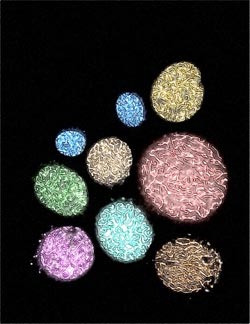A Skeleton for Chromosomes

Artistic interpretation of fluorescent light micrographs of Wapl depleted nuclei which show cohesin vermicelli. The nuclei have been pseudo-colored and scaled to different sizes. IMP<br>
Every single cell in the human body contains an entire copy of the genetic blueprint, the DNA. Its total length is about 3.5 meters and all of it has to fit into the cell’s nucleus, just one-hundredth of a millimeter in diameter.
Blown up in proportion, this would equal the task of squeezing a 150km long string into a soccer ball. Just how the cell manages to wrap up its DNA so tightly is still poorly understood.
One way of compacting DNA is achieved by coiling it tightly around histone-proteins. This mechanism has been studied in detail and is the focus of an entire discipline, Epigenetics. However, simple organisms such as bacteria have to manage their DNA-packaging without histones, and even in human cells histones probably cannot do the job on their own.
A new role for an old molecule
A team of scientists at the Research Institute of Molecular Pathology (IMP) in Vienna can now present evidence for an additional mechanism involved in structuring DNA. Managing Director Jan-Michael Peters and his research group discovered that a protein-complex named cohesin has a stabilizing effect on DNA. In evolutionary terms, cohesin is very old and its structure has hardly changed over billions of years. It was present long before histones and might therefore provide an ancient mechanism in shaping DNA.
Cell biologists are already familiar with cohesin and its role in cell division. The protein-complex is essential for the correct distribution of chromosomes to daughter cells. It forms a molecular ring that keeps sister-chromatids together until the precise moment when segregation takes place. This function and the molecular structure of cohesin have been discovered by IMP-scientists in 1997.
Antonio Tedeschi, a postdoc in the group of Jan-Michael Peters, has now found evidence that cohesin supports the architecture of DNA in non-dividing (interphase) cells. He analyzed cells in which he had shut down the function of Wapl. This protein controls how tightly cohesin binds to DNA. Without Wapl, cohesin is ‘locked’ onto chromatin in an unusually stable state. As a consequence, cells are unable to express their genes correctly and cannot divide.
Vermicelli keep DNA in shape
When he analyzed Wapl-depleted cells under the microscope, Tedeschi found elongated structures that he called “vermicelli” (Italian for small worms). Since one vermicello is present for each chromosome, he concluded that its function is to keep chromosomes in shape, rather like a skeleton.
“We think that the vermicelli are the ‘bones’ of interphase chromosomes”, says Jan-Michael Peters. “Just like our bodies depend on the bones for support, the cells depend very much on cohesin to retain their structure.”
The importance of the cohesin-system becomes obvious in cases where it is impaired. Several rare congenital diseases have been linked to mutations in the respective gene. The faulty structure of the cohesin molecule causes severe developmental retardation and is a serious medical condition. There are no causal therapies available at present.
Original publication: Wapl is an essential regulator of chromatin structure and chromosome segregation. Antonio Tedeschi et al. Doi: 10.1038/nature12471
About the IMP
The Research Institute of Molecular Pathology (IMP) in Vienna is a basic biomedical research institute largely sponsored by Boehringer Ingelheim. With over 200 scientists from 30 nations, the IMP is committed to scientific discovery of fundamental molecular and cellular mechanisms underlying complex biological phenomena. Research areas include cell and molecular biology, neurobiology, disease mechanisms and computational biology.
Contact
Dr. Heidemarie Hurtl
IMP Communications
Dr. Bohr Gasse 7
1030 Vienna, Austria
Tel.: (+43 1) 79730 3625
Mobile: (+43 1) 664 8247910
hurtl@imp.ac.at
Scientific Contact:
Dr. Jan-Michael Peters
jan-michael.peters@imp.ac.at
Media Contact
More Information:
http://www.imp.ac.atAll latest news from the category: Life Sciences and Chemistry
Articles and reports from the Life Sciences and chemistry area deal with applied and basic research into modern biology, chemistry and human medicine.
Valuable information can be found on a range of life sciences fields including bacteriology, biochemistry, bionics, bioinformatics, biophysics, biotechnology, genetics, geobotany, human biology, marine biology, microbiology, molecular biology, cellular biology, zoology, bioinorganic chemistry, microchemistry and environmental chemistry.
Newest articles

Silicon Carbide Innovation Alliance to drive industrial-scale semiconductor work
Known for its ability to withstand extreme environments and high voltages, silicon carbide (SiC) is a semiconducting material made up of silicon and carbon atoms arranged into crystals that is…

New SPECT/CT technique shows impressive biomarker identification
…offers increased access for prostate cancer patients. A novel SPECT/CT acquisition method can accurately detect radiopharmaceutical biodistribution in a convenient manner for prostate cancer patients, opening the door for more…

How 3D printers can give robots a soft touch
Soft skin coverings and touch sensors have emerged as a promising feature for robots that are both safer and more intuitive for human interaction, but they are expensive and difficult…





















